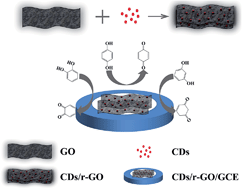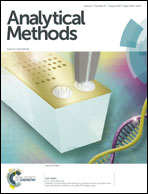Highly sensitive simultaneous electrochemical determination of hydroquinone, catechol and resorcinol based on carbon dot/reduced graphene oxide composite modified electrodes†
Abstract
In this work, a simple and highly sensitive electrochemical method was developed for the simultaneous detection of hydroquinone (HQ), catechol (CC) and resorcinol (RC) based on a carbon dot/reduced graphene oxide composite on a glassy carbon electrode (GCE). The electron communication between reduced graphene oxide (r-GO) and CDs can be further strengthened via hydrogen bonding and π–π stacking forces. The electrochemical behavior of the CD/r-GO/GCE sensor toward HQ, CC and RC was probed by cyclic voltammetry (CV) and differential pulse voltammetry (DPV). The results showed that the calibration curves were in the range of 0.5 to 1000 μM, 1.0 to 950 μM and 5.0 to 600 μM, respectively. The detection limits for HQ, CC and RC were 0.17 μM, 0.28 μM and 1.0 μM (S/N = 3), respectively. Moreover, the sensor has been successfully applied in detecting tap water, river water and industrial sewage.


 Please wait while we load your content...
Please wait while we load your content...